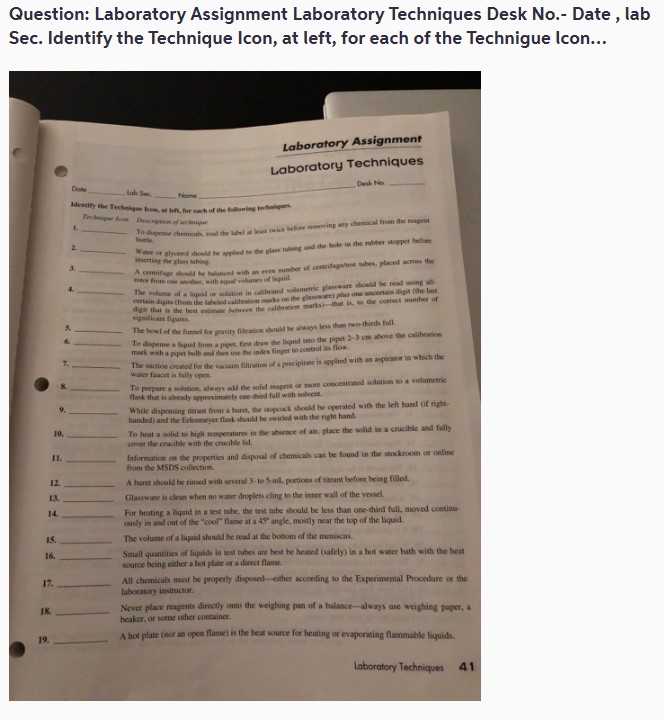QQuestionAnatomy and Physiology
QuestionAnatomy and Physiology
# Question: Laboratory Assignment Laboratory Techniques Desk No.- Date, lab Sec. Identify the Technique Icon, at left, for each of the Technique Icon...
| Laboratory Assignment Laboratory Techniques | | |
| --- | --- | --- |
| Date | Lab Sec. | Name |
| Identify the Technique Icon, at left, for each of the following techniques. | | |
| Technique Icon | Description of technique | |
| 1. | To dispense chemicals, read the label at least twice before removing any chemical from the reagent bottle. | |
| 2. | Water or glycerol should be applied to the glass tubing and the hole in the rubber stopper before inserting the glass tubing. | |
| 3. | A centrifuge should be balanced with an even number of centrifuges/test tubes, placed across the outer hole one another, with equal volumes of liquid. | |
| 4. | The volume of a liquid or solution in calibrated volumetric glassware should be read using all-certain digits (from the labeled calibration marks on the glassware) plus one uncertain digit (the last digit that is the best estimate between the calibration marks)—that is, to the correct number of significant digits. | |
| 5. | The bowl of the funnel for gravity filtration should be always less than two-thirds full. | |
| 6. | To dispense a liquid from a paper, first draw the liquid into the pipet 2 - 3 cm above the calibration mark with a pipet bath and then use the index finger to control its flow. | |
| 7. | The suction created for the vacuum filtration of a precipitate is applied with an aspirator in which the water faucet is fully open. | |
| 8. | To prepare a solution, always add the solid reagent or more concentrated solution to a volumetric flask that is already approximately one-third full with solvent. | |
| 9. | While dispensing titrant from a burst, the stopcock should be operated with the left hand (if right-handed) and the Erlenmeyer flask should be swirled with the right hand. | |
| 10. | To heat a solid to high temperature in the absence of air, place the solid in a crucible and fully cover the crucible with the crucible lid. | |
| 11. | Information on the properties and disposal of chemicals can be found in the stockroom or online from the MSDS collection. | |
| 12. | A burst should be raised with several 3 - to 5 -mL portions of titrant before being filled. | |
| 13. | Glassware is clean when no water droplets cling to the inner wall of the vessel. | |
| 14. | For heating a liquid in a test tube, the test tube should be less than one-third full, moved continuously in and out of the "cool" flame at a 45° angle, mostly near the top of the liquid. | |
| 15. | The volume of a liquid should be read at the bottom of the meniscus. | |
| 16. | Small quantities of liquids in test tubes are best be heated (safely) in a hot water bath with the heat source being either a hot plate or a direct flame. | |
| 17. | All chemicals must be properly disposed—either according to the Experimental Procedure or the laboratory institution. | |
| 18. | Never place reagents directly onto the weighing pan of a balance—always use weighing paper, a beaker, or some other container. | |
| 19. | A hot plate (not an open flame) is the heat source for heating or evaporating flammable liquids. | |
Laboratory Techniques 4.1
Attachments

6 months agoReport content
Answer
Full Solution Locked
Sign in to view the complete step-by-step solution and unlock all study resources.
Step 1I will provide solutions for the first five technique icons.
For each technique, I will describe the technique and explain the reasoning behind it.
Step 2
Technique: Proper handling of chemicals Description: To dispense chemicals, read the label at least twice before removing any chemical from the reagent bottle. Reasoning: This technique is crucial for safety and accuracy. Reading the label twice ensures that you have the correct chemical and reduces the risk of contamination or accidents.
Final Answer
1. Proper handling of chemicals: To dispense chemicals, read the label at least twice before removing any chemical from the reagent bottle. 2. Lubricating glass tubing: Water or glycerol should be applied to the glass tubing and the hole in the rubber stopper before inserting the glass tubing. 3. Balancing a centrifuge: A centrifuge should be balanced with an even number of centrifuges/test tubes, placed across the outer hole one another, with equal volumes of liquid. 4. Reading calibrated volumetric glassware: The volume of a liquid or solution in calibrated volumetric glassware should be read using all-certain digits (from the labeled calibration marks on the glassware) plus one uncertain digit (the last digit that is the best estimate between the calibration marks)—that is, to the correct number of significant digits. 5. Gravity filtration funnel: The bowl of the funnel for gravity filtration should be always less than two-thirds full.
Need Help with Homework?
Stuck on a difficult problem? We've got you covered:
- Post your question or upload an image
- Get instant step-by-step solutions
- Learn from our AI and community of students